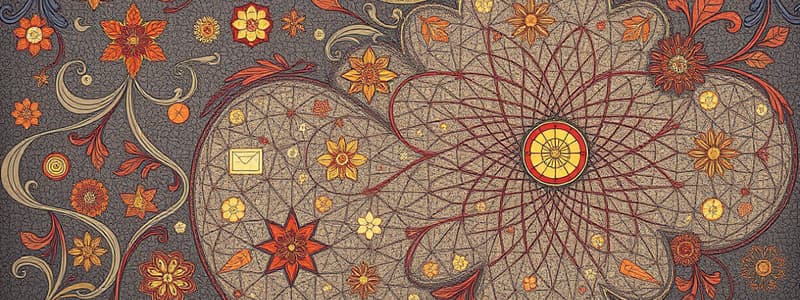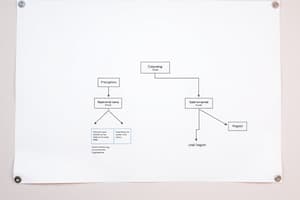Podcast
Questions and Answers
What describes the purpose of the message arrow in a sequence diagram?
What describes the purpose of the message arrow in a sequence diagram?
- It represents the lifespan of an object.
- It shows the iteration of a process.
- It indicates the operation signature and direction of communication. (correct)
- It provides additional comments about the process.
Which of the following elements is NOT an essential part of a sequence diagram?
Which of the following elements is NOT an essential part of a sequence diagram?
- Return
- Graphical representations (correct)
- Sequence number
- Object lifeline
How can iteration be indicated in a sequence diagram?
How can iteration be indicated in a sequence diagram?
- By marking it with a star symbol.
- By placing square brackets around a condition. (correct)
- By using a dotted line.
- By numbering the sequences.
What is the role of sequence numbers in a sequence diagram?
What is the role of sequence numbers in a sequence diagram?
Which symbol is used to indicate a self-reference in a sequence diagram?
Which symbol is used to indicate a self-reference in a sequence diagram?
What does the activation bar in a sequence diagram represent?
What does the activation bar in a sequence diagram represent?
What does the return element in a sequence diagram signify?
What does the return element in a sequence diagram signify?
Which symbol is used to indicate a timeout event in a sequence diagram?
Which symbol is used to indicate a timeout event in a sequence diagram?
What is a key advantage of using sequence diagrams?
What is a key advantage of using sequence diagrams?
Which of the following is true regarding anonymous objects in a sequence diagram?
Which of the following is true regarding anonymous objects in a sequence diagram?
Which component is necessary to convey additional information in a sequence diagram?
Which component is necessary to convey additional information in a sequence diagram?
In the ATM withdrawal case, what does the machine do after verifying customer authentication?
In the ATM withdrawal case, what does the machine do after verifying customer authentication?
What does an asynchronous event signify in a sequence diagram?
What does an asynchronous event signify in a sequence diagram?
What does the stick arrowhead represent in a sequence diagram?
What does the stick arrowhead represent in a sequence diagram?
In the library management system, why must the member be verified before booking a journal?
In the library management system, why must the member be verified before booking a journal?
What does object termination symbolize in a sequence diagram?
What does object termination symbolize in a sequence diagram?
What is the primary focus of a sequence diagram?
What is the primary focus of a sequence diagram?
Which of the following is NOT an aspect that a sequence diagram can model?
Which of the following is NOT an aspect that a sequence diagram can model?
In the context of a sequence diagram, what is the first step when interacting with objects?
In the context of a sequence diagram, what is the first step when interacting with objects?
Which entities were illustrated in the example sequence diagram provided?
Which entities were illustrated in the example sequence diagram provided?
What is a common use case for developing a sequence diagram?
What is a common use case for developing a sequence diagram?
Which term is used interchangeably with sequence diagrams?
Which term is used interchangeably with sequence diagrams?
What is essential for building a sequence diagram effectively?
What is essential for building a sequence diagram effectively?
Which of the following best describes the role of objects in a sequence diagram?
Which of the following best describes the role of objects in a sequence diagram?
What action does the librarian take when a journal is requested from a different campus?
What action does the librarian take when a journal is requested from a different campus?
What does the office clerk check to provide room and bed options to a patient?
What does the office clerk check to provide room and bed options to a patient?
Under what condition is a borrowing request denied for a regular student?
Under what condition is a borrowing request denied for a regular student?
What roles are involved in the process of admitting a patient to a hospital room?
What roles are involved in the process of admitting a patient to a hospital room?
What is created when a student wishes to borrow books?
What is created when a student wishes to borrow books?
What happens after the office clerk finds available room and bed options?
What happens after the office clerk finds available room and bed options?
What does the system check before allowing book borrowing?
What does the system check before allowing book borrowing?
What type of medical advice typically precedes room or bed allocation?
What type of medical advice typically precedes room or bed allocation?
Flashcards are hidden until you start studying
Study Notes
Sequence Diagram Overview
- A sequence diagram is an interaction diagram that illustrates the order of processes and how they interact.
- It represents object interactions in a time sequence, detailing the objects/classes involved and the messages exchanged.
- Useful for visualizing how objects communicate, enhancing understanding of complex systems.
Key Features of Sequence Diagrams
- Emphasizes time ordering of messages, enabling modeling of sequential flows, branching, iteration, recursion, and concurrency.
- Sometimes referred to as event diagrams or event scenarios.
- Building a sequence diagram is easier with a first draft of the Use Case model and Class diagram.
Fundamental Elements of Sequence Diagrams
- Participants/Objects: Entities involved in the interaction.
- Messages/Stimuli: Communications exchanged between objects.
- Object Lifeline: Represents the existence of an object over time.
Extended Elements of Sequence Diagrams
- Activation Bar: Indicates when an object is active during the interaction (a vertical rectangle).
- Deactivation: Marks the end of an object's activation.
- Timeout Event: Denoted by a clock face or circle on the line.
- Asynchronous Event: Signified by a stick arrowhead for messages that do not require an immediate response.
- Object Termination: Represented by an "X", indicating the end of an object's lifecycle.
Importance of Sequence Diagrams
- Offer a higher-level perspective above the coding level, providing a clearer view of system interactions.
- Language-independent, allowing for broader applicability across different programming languages.
- Facilitate collaborative work among teams and provide a comprehensive view of multiple objects/classes simultaneously.
Exercises for Sequence Diagram Practice
-
ATM Withdrawal Transaction:
- Customer inserts ATM card, machine verifies authentication, and processes withdrawal request.
-
Library Management System - Journal Booking:
- Member requests to book a journal; librarian verifies member status, locates journal, and completes booking.
-
Hospital Room or Bed Request:
- Doctor advises patient on room need; clerk checks availability and completes booking process, informing patient.
-
Library System - Book Borrowing:
- Student attempts to borrow books; the system verifies status and checks for overdue items before finalizing the borrowing process.
Studying That Suits You
Use AI to generate personalized quizzes and flashcards to suit your learning preferences.




